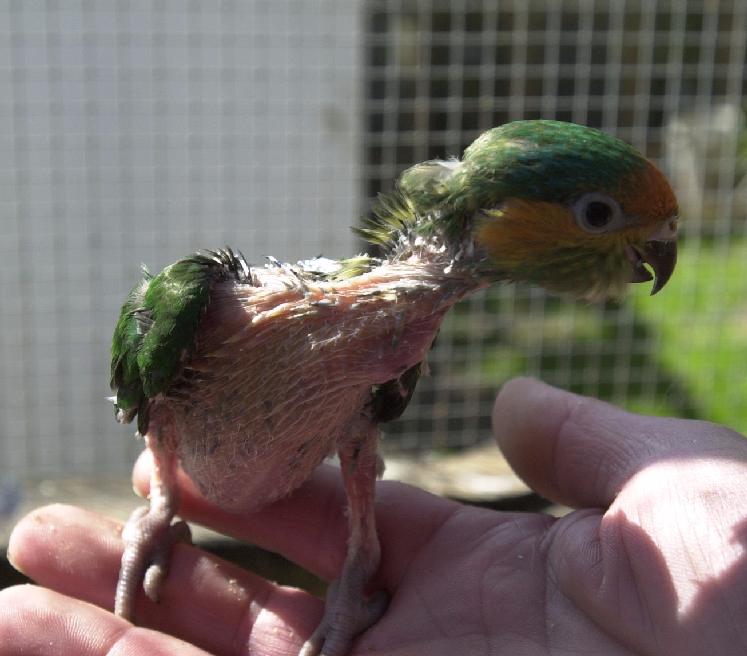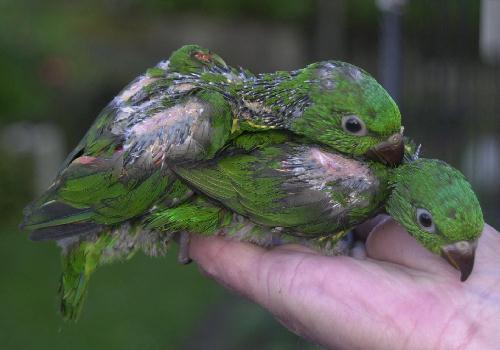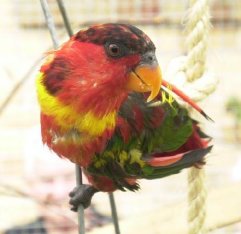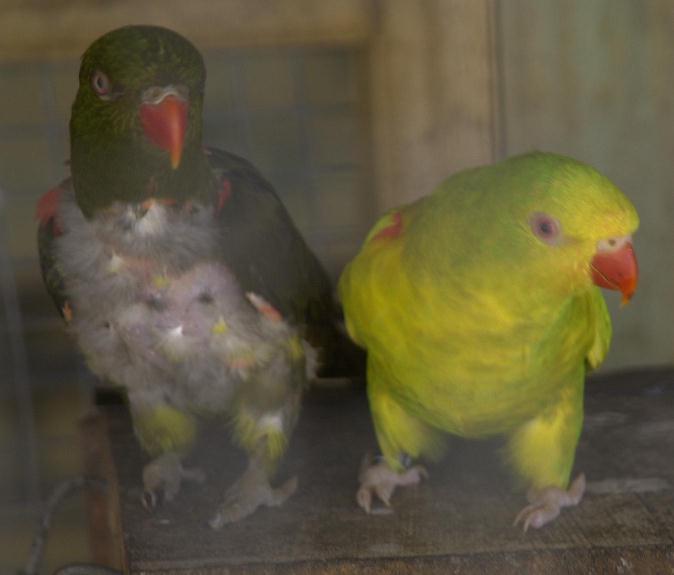Feather Plucking
by David Dix
When talking to other parrot owners and breeders about their birds one of
the most common problem issues mentioned is birds that are feather plucked
and what could be the possible reasons for this behaviour.
This is one of those almost impossible questions to answer as eveyone will
have their own ideas on the cause.
Lories are no exception to this problem and feather plucking appears to be
quite common amongst caged and aviary kept lories, some actually say its
more of a problem for lories because they are intellgent and active parrots
that can suffer from boredom and stress issues - that may lead to the feather
plucking (or other abnormal behaviour).
Before looking at boredom and stress issues there could be a more obvious
reasons why the lory appears plucked (or featherbare or has areas of thinning
plumage or bald spots etc..). Some of these are listed below and should be
eliminated as possible reasons.
Plumage not right!
Feathers dropped during the moult should be obvious on the cage/aviary
floor. Inspect these dropped feathers to see they are not mis-shapen or
diseased/contaminated in some way.
If this process lasts for more than a few weeks then it may be necessary to get the bird checked by a vet.
(to check there is no PBFD - see below, or other plumage problems)
Where it is suspected that a bird is being victimised then immediate action to
remove either bully or victim may be necessary and a serious fight could
develop leading to the death of the weaker bird.
Also inspect the feather plucked site as there may be a more serious
underlying wound.
Sometimes it is the cock bird
whose feathers are used and it may be the hen plucking him! Even though not
sitting on eggs or preparing to lay this behaviour can continue.
In one of the images below a male olive Scaly lorikeet has been plucked by
his mate, a yellow/cinnamon hen Scaly. She appears to do this for nest lining.
If plumage thinning is obvious then get the bird to the vet for a checkup
and possibly a PBFD test.
An image of a young Yellow-bib with beak and feather disease is shown below,
the plumage has become quite sparce in areas giving the impression she has been
feather plucked.
Small amounts of parasite spray (such as Frontline for dogs/cats) will
often remedy the parasite problem although a vet visit may still be a
good idea.
This can be a serious problem as
sometimes this plucking can damage the nestlings' skin causing infections or
at worst, cock birds have been known to multilate and kill their nestlings.
When plucked nestlings are discovered the best remedy is to remove them and
hand-rear until fledged.
The images blow show a musk lorikeet that has been severely plucked with most
of his body plumage removed and the parents were just starting on his wings
when he was removed. Another image is of
a five week old pair of scalies where
the back and upper wing feathers have been removed. In both cases they
were removed for hand-rearing. The nestboxes of their parents are now
regularly inspected when they have nestlings.
Severely plucked Musk lorikeet nestling |
Pair of five week old plucked Scaly lorikeets |
Yellow-bib with Beak and Feather disease |
Olive Scaly cock plucked by hen |
After eliminating the above possibilities then the task becomes more difficult.
Health Check
First, any health issues should be eliminated and the best thing to do here
is get the bird to an avian vet for a checkup. Checks should include that
the bird is properly nourished, the correct weight, has no yeast/fungal or
bacterial infections and appears overall (not counting the feather plucked
areas) in good health.
Assuming the bird has a clean bill of health then it is time to consider
less obvious reasons for the feather plucking. The two main concerns here are
boredom and stress.
BOREDOM
Lories and lorikeets, being very active and intelligent parrots, can quite
easily become bored when there is just not enough activity to keep them
moving and their minds alert.
A bored bird can start to mutilate itself
by removing any feathers it can reach. This behaviour can be very difficult
to remedy but the smart bird owner should try to avoid boredom ever occuring
in the first place. Below are some issues that should be looked at.
Large enough space?
The cage of aviary should be large enough so that the bird does not have
to perch for long periods in one location. Ideally it should be able to not
only walk around but have room to fly as well. If this is not possible then
it will need periods outside the cage where it can exercise and fly.
(I do not agree with wing clipping to force a bird not to fly although for
many owners this is a necessary evil)
If space permits then a private area should be available, perhaps a
curtained off corner or nestbox or open ended box etc., this may give the
bird some security in being able to hide away if it wants or needs to.
There are many different sizes and types of cages available from many
suppliers advertising on the internet. Viewing their online stores can often
provide ideas on cages suitable for various birds.
An aviary will generally need at least two metres of free space to allow the
lory to fly although the longer and roomier the better.
Toys
There should be toys, swings, ropes and all sorts of activity items to
keep the bird busy and let it have fun. Introducing a new toy, relacing
perches and placing plants etc., in the aviary can give the bird new
things to explore and new items to play with.
Be careful introduing a new toy that it does not scare the bird. A timid bird
may react badly to suddenly placing that noisy bell, loud sqeaky thing, or
rattly device in its cage space. Most birds will need to give new items a
thorough inspection from all angles and distances but should soon be
investigating it and having fun.
Also consider making toys as this can quite low costs and allow new toys
to be introduced on a more regular basis
Companion bird
A solitary bird will often have an instant cure for boredom when a mate
or similar bird is introduced. This may hav to be a gradual process to
avoid a whole new set of problems but most bird will fairly quickly become
interested in a new companion or possible mate (try to get the same type
of bird but different sex!)
Food
The bird could be bored with its food, try introducing something different,
there are many recipes available for dry and wet mixes as well as
commercially available mixes and pellets - Durch mix and Kaytees are two of
the most popular and most birds will just love it.
Try just about every variety of fruit, including dried fruit and fruit
juices - but not energy/sports fruit drinks,
and greens including dandelion and some root vegetables such as carrot, radish,
etc..
The occasional treat of a biscuit (not chocolate), bread with honey or jam,
small piece of cake, breakfast cereal or cereal bar and even a teaspoon of
fruit yoghurt. Honey water, Apple vinegar water and water with a little vegetable juice are
occasionally acceptable.
The keyword with food is variety with no excess of any one food type.
Change surroundings
The bird could be bored with its surroundings, try moving it somewhere else,
perhaps to a brigher location if it is not seeing too much natural light.
If it is exposed to periods of direct sunshine then maybe it needs some shade
or some part of its cage/aviary that is in the shade.
Can it look out to interesting surroundings or does it just see the same
unchanging walls?
Routine
Although pet birds will tend to adapt to a set routine of events in their daily
life and possible get some security from this routine it may be an idea to look
at this aspect of its life and see if any non-stressing changes can be made
that would make the daily routine more interesting or even exciting for the
bird. Perhaps an additional play period from time to time or a snack at
random times or moving it to a different location for an hour or so or even
outside to the garden for a while in fine weather.
Human Attention
It may not be getting enough attention from its human. Maybe it needs more
person-time, more playing time, more flying around the room time or just
more time perching/sleeping/playing/watching TV while on its human's
shoulder/arm/head etc..
Following from this is the bird that is just being ignored by its owners.
If the owner's lifestyle is just too busy to spend any time with the bird
then serious though should be given to relocating it to someone who does
have the time. Many people would just love a 'companion' bird as much as
a bird loves a 'companion' human.
Most Lories will beg for attention, this can be seen when the lory perches in
a low stance with wings just slightly extended and fluttering.
Continued behaviour like
this is a sure indication the lory needs more of its human's time.
STRESS
A stressed bird is not a happy bird and this can also lead to feather plucking.
Identifying the reasons for stress is the problem as its often surprising to
the bird owner how small or almost insignificant changes can really upset
their pet.
Just about all reasons for stress are due to a fear of something unknown or
something new or something familiar being removed.
Needs a mate:
When lories mature they often start to become nippy and apparently less
human friendly. This can be very concerning for the owner if this behaviour
develops into feather plucking. It seems the lory has underwent a complete
personality change, more so noticeable with males.
Often these changes occur because the lory has reached the stage it wants a
mate and wants to make new lories. The only solution here is to find a
suitable mate for the lory.
Environment changes:
If there has been some obvious change to the birds environment before the
feather plucking started then consider undoing that change. This can apply to
simple things such as moving furniture or a new item that has been placed
near the bird or the bird's cage has been relocated.
Look out for changes that include the bird now being in direct sunlight or
exposed to a draught, fumes from a heater or fire, higher or lower
temperatures, something is blocking its normal view etc..
Do not allow smoking near the bird or people who must blow smoke at pets.
Most birds will have no problems adapting to changes but some are just not
able to cope.
Human owner
Most pet birds or even aviary birds will tend to bond more closely to one
human, most likely the one feeding it and that spends most time with it.
Stress is certain if this peson changes or leaves altogether for just a
few days. Many are the reports of owners going for a few days holiday and
returning to a feather plucked bird.
Other humans and pets:
A bird has come into contact with a different human or another pet can
become stressed.
Never allow a person unfamiliar with a bird to handle it as they may react
to a nip by viciously swiping the bird or throwing it on the ground.
Stop people rattling cages or poking fingers into the bird cage.
(these same people tend to annoy fish by tapping their aquarium!).
Children can often unintentionally hurt/stress bird as they may not
understand the bird is not a toy, keep children away unless they have been
taught how to handle birds.
A persistent or curious new dog or cat, a new bird or other pet may scare
or threaten the pet bird. A neighbour's pet cat/dog may be way too
inquisitive, time for that electric fence around the aviary!
Routine changes:
A bird quickly comes to understand and settle into a daily routine, they
appear to get some security from knowing what is going to happen and when.
Most can accept changes to this routine but some birds will stress out
usually by becoming noisy or nippy. Sometimes feather plucking.
Other stressful changes:
new noises such as building, roadworks - hopefully these will go away soon.
change of cage or aviary, more difficult to deal with but retaining some
familiar items is a good idea - such as a nestbox or familiar toy,
loss of mate or companion bird, get a replacement quickly! preferably of
the same type but opposite sex!
Still plucking?
Many parrots that feather pluck will unfortunately never be cured from this
self-mutilating habit. Although the initial reason for starting to feather
pluck has been resolved the bird may continue plucking even through the
boredom, stress or health issues have been addressed.
The extra attention the bird received from its worried owner when the plucking
was first discovered, or the new food it received or changed surroundings,
may all have sent the wrong message to the bird and it has learned that
plucking is the way to get what it wants.
The owner may end up with no other choice but to accept their 'new look'
bird.



